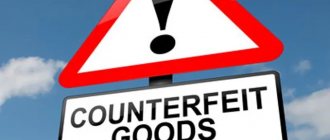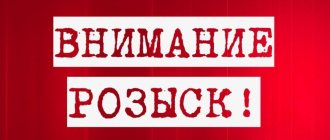Recently, more and more often in the news you can hear that the fight against counterfeiting is underway or learn about the arrest of counterfeit products. But few people know what it is. Unfortunately, in recent years, throughout the Russian Federation, the number of crimes related to the economy, namely the production, export and import of counterfeit products, has increased significantly.
Counterfeiting is a problem not only in the Russian Federation, but throughout the world. Unfortunately, quite often in the news it is said that people have been harmed by these products. This happens because people buy goods and often do not pay attention to logos. The Criminal Code (hereinafter referred to as the Criminal Code of the Russian Federation) contains several articles devoted to this problem, but it is not always possible to prove an offense.
The concept of counterfeit
The term “Counterfeit” refers to products on which a trademark has been illegally applied.
It is possible to vary the cost (not always low), quality characteristics (not always bad), and manufacturer. Counterfeits are more common in the mass market. They counterfeit a product that they already know, i.e. has a famous name.
I would like to note that the concept of “counterfeit” is not always even associated among our consumers with the word “bad”, “poor quality”.
However, counterfeit goods pose a threat due to the use of low-quality materials by unscrupulous manufacturers (for example, poorly manufactured spare parts, “wrong” composition of medicines, food products, cosmetics for the face and body). Such products do not have a license or certificates, so trusting the quality is fraught with danger to your own health.
Legal aspect
Counterfeit goods pose a very real threat to individual companies and to the Russian economy as a whole. Companies suffer enormous losses from activities related to these goods. Damages amount to approximately three billion dollars annually. Counterfeits are produced both in factories and in private enterprises. The Russian Federation ranks second among producers of counterfeits, China rightfully takes first place.
Almost no one knows what counterfeit is. And even if you ask a passerby whether he has ever encountered these goods in his life, he will answer that he has not. Although in fact, every resident of our country encounters these products every day. It surrounds us everywhere: at home, at work, on the street. We hear about it on the news on TV and radio, and read in newspapers. Nowadays, the relevance of the issue of combating the spread of counterfeits in the Russian Federation is increasing, since low-quality products are increasingly found on the market. Every citizen can read about this in the newspaper, or hear about it in the news, or come across it in their own life, but not everyone can talk about counterfeit products and say what it is. As a result, people cannot distinguish a counterfeit from an original.
Counterfeit products (counterfeit) are goods that were manufactured in violation of intellectual property rights. This means that the copyright holder does not receive any benefit from the sale of counterfeit goods. The concept of counterfeit has a legal nature, so disagreements with the manufacturer can be resolved by going to court. All issues that arise regarding counterfeiting are resolved in accordance with the Administrative Code and the Criminal Code. In accordance with the Criminal Code, the consumer can resolve all issues in court if the distributor does not make contact with the consumer. A product is considered a counterfeit product only if copyright infringement occurs.
Read also: Procedure for depriving mentally ill citizens of legal capacity and other cases of restriction
Quite often, counterfeit products are confused with counterfeit products. In fact, what these products have in common is that both are fakes. Quality is considered a distinctive feature. A counterfeit is a low-quality fake, while a counterfeit is a product that is almost as good as the original.
Thanks to these products, the country's shadow economy is thriving. But at the same time, a large number of well-known companies suffer losses, their authority is discredited, since buyers often cannot distinguish an original product from a fake.
Types of counterfeit products
To make it easier to understand the abundance of goods offered, let’s consider the types of counterfeit products that are found on our market:
- The use of a well-known logo or one similar to it, which is why brands are easily confused. For example, "Samsung" and "Sumsang".
In such a situation, the manufacturer has the right to deny the presence of a counterfeit. After all, no one used the original name. But this will not protect ordinary buyers. Ordinary users often do not know in detail the details depicted on the desired logo. When ordering a product, they often rely on a figurative image.
- Counterfeiting the appearance and shape of a product, design features.
- Illegal distribution and copying of multimedia, books and software - the release of pirated discs, literature and other works of art, including their distribution on the Internet, is considered a gross violation of copyright.
- Illegal exploitation of patented technical solutions.
- Installation and use of software and various computer programs without permission from the copyright holder.
Counterfeiting, parallel imports and parasites: intellectual property issues
Vitaly Kalyatin, chief intellectual property lawyer at Rusnano Group, spoke about changes in legislation that are currently being worked on and the adoption of which can be expected in the near future. “There are a lot of bills that regulate this area, but I will tell you about a few that have a fairly high chance of adoption,” he began.
New laws and resolution of the Plenum of the Supreme Court
Kalyatin singled out the bill on geographical indications as the first of these initiatives. “The project is actively supported and will most likely be accepted. It simplifies the process of registering an object of intellectual property, because a geographical indication is a reflection of the specific properties of a product and its reputation, and there is no exclusivity of the characteristics that are required for the appellation of origin of a product (AP),” the lawyer explained. But with this, according to the expert, one problem arises: what is the point of distinguishing between a geographical indication and an appellation of origin? “Work on the bill continues, and perhaps this distinction will appear. In general, this is a fairly useful novelty, but, on the other hand, it is not very clear why it is needed,” said Kalyatin.
Deputies proposed introducing a new object of intellectual law into the Civil Code - geographical indication
Kalyatin also spoke about the bill on computer programs and databases, which introduces new types of contracts for the provision of information services. The norm of the agreement on the provision of information services is divided into two types - when access to information is provided and the so-called “cloud” ones, the expert said. The same bill, he said, clarifies the terminology. Several definitions are emerging for terms relevant to the protection of computer programs: the concept of source text, object code, audiovisual images generated by computer programs, and so on.
And in Art. 1261 of the Civil Code on computer programs introduces the concept of “version”. "What's the point? Firstly, the law establishes that the author of computer programs has the right to all versions of the program: this simplifies the protection of his rights. Secondly, it makes it easier for users. The Civil Code in the new version says that the user of the program has the right to use all versions that arise during the update process. If the copyright holder provides an update, then he also provides the right to use the new version of the program,” Kalyatin explained the novel.
Another initiative that is in development is a bill on shared ownership of intellectual property rights. As planned, it will be possible to dispose of shares in the right and establish a procedure for disposing of this share. In addition, the issue of distribution of expenses carried out in the interests of copyright holders is resolved. Finally, the novel also provides for the establishment of a pre-emptive right to purchase a share in the right. “Not many rules are being introduced, but they resolve all the basic issues about shared ownership of rights,” the expert said.
In addition to direct legislative initiatives, Kalyatin announced a resolution of the Plenum of the Supreme Court, which has been prepared “for many years now,” and now this process has reached the “final stage,” and already at the beginning of 2022, “it will probably be considered at the Plenum.” “The document is very voluminous; it includes all the explanations that the highest courts gave for Soviet and Russian history. There are few revolutionary changes, but there are a significant number of solutions to practical issues, clarifications that practice requires,” Kalyatin emphasized.
How to fight counterfeit?
The law distinguishes two types of intellectual property violations: parallel imports and counterfeiting. In many ways, the position of courts and departments is very different, and it is easier to fight counterfeits than parallel imports, said Boris Malakhov, partner at Lidings.
Even from the point of view of the law, and especially from the point of view of practice, the approach to these types of violations is significantly different. With regard to counterfeit goods, we have great concern: it is considered to be a serious public offense, therefore its sale is actively suppressed through even criminal liability.
At the same time, parallel import is more of a commercial issue. Figuratively speaking, this is a violation of the distribution scheme. Therefore, often such doctrinal and factual differences between these two regimes cause us to react to them differently.
Boris Malakhov, partner in the intellectual property protection practice of Lidings Lidings Federal rating. Pharmaceuticals and healthcare group Intellectual property group (Protection of rights and litigation) Intellectual property group (Registration) Arbitration proceedings group (major disputes - high market) Intellectual property group (Consulting) TMT group (telecommunications, media and technology) Labor and migration law group (including disputes) 6th place by revenue per lawyer (less than 30 lawyers) 18th place by revenue 29th place by number of lawyers
Customs is identifying more and more counterfeits - that is, non-original goods with a trademark not applied by the copyright holder. According to the lawyer, in the first half of 2022, customs detected more counterfeit goods than in the whole of 2022. And before fighting counterfeit and parallel imports, it is necessary to determine what kind of violation is being fought. To do this, you can use various methods: Malakhov, for example, uses the so-called “Abibas rule”. “Any attempts to change the original brand are a sure sign of counterfeit,” he explained.
Determining a way to counter violation of trademark rights, Malakhov called for assessing the brand, volume and seriousness of the violation, assessing the budget for legal and time expenses, choosing the right tactics between speed, compensation and a strong precedent, and resorting to preventive measures. For example, brand registration, crime monitoring, support services, and others.
Speaking about ways to protect their rights, Malakhov noted the judicial procedure. “In my understanding, the court is the most effective way to protect your intellectual rights. But more often than not, it’s the trial that costs the most.” According to Malakhov, going to court has other disadvantages. For example, it is difficult to request information about the scope of violations, and there is no uniform approach to this issue in judicial practice.
“I don’t quite understand why businesses turn to the antimonopoly service to protect their rights. FAS is not so interested in protecting the specific economic interests of the copyright holder, especially when it comes to parallel imports. But through the FAS it is very convenient to request information about the volume of violations from retail chains. It’s good to contact them if you want a big dispute for big money,” the lawyer shared his experience.
| Counterfeit | Parallel import | Efforts | Deadlines | Compensation | Seizure of goods | Request for information | Predictability |
| Court | |||||||
| FAS | |||||||
| Customs | |||||||
| on-load tap-changer | |||||||
| Police |
Table: green shows the effectiveness of the chosen method according to a certain criterion according to the expert, red – on the contrary, ineffectiveness.
Customs, Malakhov said, considers a very narrow category of cases. “Your task (as a copyright holder) is to convince customs that this is a pure counterfeit and not a parallel import. Otherwise, customs will never initiate a case; their goal is to protect public order from counterfeiting,” he said. The expert called the possibility of seizure of goods a plus of customs. According to him, this is the reason why the Federal Customs Service is valued specifically in the fight against counterfeiting.
Contacting Rospotrebnadzor and the police, according to the expert, are only additional methods of struggle, the effectiveness of which greatly depends on the type of products sold. And although both bodies can initiate cases of administrative violations, they do so “not actively enough.” “And although RPN has some efficiency, we often receive unsubscribes. The advantage of the police is more psychological, but it comes to criminal cases very, very rarely. There are still no advantages to the police, other than the psychological or criminal component; it is only good in combination with other methods of protecting rights,” he concluded.
An alternative method of defense was proposed by Kirill Entin - this is an appeal to the Court of the Eurasian Economic Union, where he is an adviser to the expert and analytical department.
Parallel imports: pros and cons
Parallel import is an international principle of exhaustion of rights, which means that the import of goods under a registered trademark is possible into the country by any market participants, and not just those who have received permission from the copyright holder.
In February 2022, the Constitutional Court issued Resolution No. 8-P, which actually legalized parallel imports in Russia. For example, in its decision, the Constitutional Court prohibited the withdrawal from circulation and destruction of original goods of proper quality. Svyatoslav Dubovoy and Dmitry Bobkov from Coca-Cola HBC Russia spoke about the arguments for and against parallel imports:
| Behind | Against |
| Expected decrease in wholesale prices for imported goods | Declining investment attractiveness of the Russian market |
| Increasing product range | Risk of increasing number of counterfeit products |
| Development of non-price competition | Capital outflow due to the transfer of procurement procedures abroad |
| Closure of some local production | |
| An increase in the share of imports will lead to a shortage of taxes and fees |
Another important aspect of parallel import that experts spoke about is the regime of exhaustion of trademark rights. On the territory of Russia, the national principle of exhaustion of rights applies, but this is only in accordance with the norms of the Civil Code, they clarified. “There is also a treaty on the Eurasian Economic Union, which establishes the regional principle of exhaustion of law,” the lawyers recalled and emphasized that the international treaty on the EEC has great legal force.
- SIP determines compensation for parallel imports
September 20, 8:00 - Parallel import and piracy: how to protect intellectual rights
April 19, 9:07
“At the EEC level, the regional principle of exhaustion of rights has been consolidated, and it is clear that in this regard, regulation is following the same path that the European Union took at one time,” confirmed Kirill Entin. But problems, according to him, remain, and now only Belarus and Kazakhstan have brought their laws into compliance with this norm. Kyrgyzstan, Armenia and Russia retain the national principle of exhaustion of rights. “Nevertheless, it is important to remember that EEC law is supranational, it is based on international treaties that have priority, so this norm is valid even without legislative codification,” he emphasized.
“Currently, within the framework of the regional principle of exhaustion of rights, goods are often imported, for example, from Kazakhstan. Consumers often complain about such products. For example, we are faced with the fact that different advertising companies operate in the territories of these countries. And how can we track the defective bottle from Kazakhstan? We worry primarily about the quality of the products,” Dubova shared his experience.
What are the regimes for the exhaustion of rights to a trademark?
International – the introduction of an intellectual property object (IPO) into circulation anywhere in the world deprives the copyright holder of his exclusive rights in relation to this IPO in all other countries.
Regional – the exhaustion of rights in relation to intellectual property occurs simultaneously in the corresponding region, which includes the territories of several states at once.
The national owner controls only the first sale of the intellectual property in the territory of a certain country, through which the exclusive rights to subsequent sales of the intellectual property are exhausted.
According to Maxim Labzin, head of the practice of resolving disputes in the field of intellectual property from INTELLECT (INTELLECT) INTELLECT (INTELLIGENCE) Federal rating. group Digital economy group Intellectual property (Protection of rights and litigation) group Intellectual property (Registration) TMT group (telecommunications, media and technology) 15th place By number of lawyers 24th place By revenue per lawyer (more than 30 lawyers) 40th place By revenue Company profile, problems of parallel import is due to the fact that the circulation of goods cannot be interrupted and the interests of bona fide purchasers must be taken into account. “The Constitutional Court identified two possible abuses of the copyright holder: restricting imports into the Russian domestic market and inflating prices compared to other markets “to a greater extent than is typical for normal economic activity or to satisfy a reasonable economic interest,” the lawyer said.
How to reduce compensation or prevent it
The penalty for violation of intellectual rights is compensation to the copyright holder. In this case, the amount of compensation is established by law - the copyright holder can choose from the following types:
- in a fixed amount: in the amount of 10,000 rubles. up to 5 million rubles;
- in the amount of twice the cost of counterfeit goods;
- in the amount of twice the cost of the license for the use of the result of intellectual activity or means of individualization.
The Constitutional Court allowed the courts to reduce the amount of compensation for copyright infringement.
But, according to Elena Gorodisskaya from Andrey Gorodissky and Partners, current judicial practice tends to reduce the amount of compensation “to an objective level, in the opinion of the court.” This was largely facilitated by the position of the Constitutional Court, which, in its Resolution No. 28-P of December 13, 2016, allowed the courts to reduce the amount of compensation for copyright infringement in the presence of a number of circumstances. In particular, if the offense is committed for the first time, the violation of rights to intellectual property is not an essential part of the person’s activity and was not of a gross nature, and the amount of compensation is many times greater than the amount of damage caused to the copyright holder.
All decisions of the judicial authorities, which went beyond the strict requirements of the law on the amount of the penalty, were the result of the fact that the copyright holders acted immoderately and, from my point of view, not very correctly when they initially demanded huge amounts of compensation.
Elena Gorodisskaya, partner, head of the Intellectual Property practice Andrey Gorodissky and partners Andrey Gorodissky and partners Federal rating. group Intellectual Property (Registration) group Intellectual Property (Rights Protection and Litigation) group Intellectual Property (Consulting) group Corporate Law/Mergers and Acquisitions (mid market) group Tax Consulting and Disputes (Tax Consulting) group Labor and Migration Law (including disputes ) Company Profile
Current judicial practice is united in its desire to reduce the amount of compensation to an objective one, in the opinion of the court, and at the same time it is completely different in terms of the place of consideration of the dispute, Gorodisskaya said. Regional courts are happy to reduce compensation, especially when it comes to recovery from a local entrepreneur. The ASGM also reduces the amount of compensation, but to a lesser extent than regional arbitration courts. The appellate instance, according to the lawyer’s experience, practically does not reduce compensation. “Appeals, especially regional ones, in most cases simply “overpower” the decision of the first instance. This issue can be resolved by the IP, but only if the decision itself, for example, has flaws in terms of motivation,” she said.
For defendants: it is necessary to provide the entire volume of documents during consideration in the first instance in order to refute the stated amount of compensation, and provide a reasoned statement that the amount of compensation is disproportionate. “Given such documents, I do not know of cases in which the courts refuse to reduce compensation. The trend is that the courts are reducing compensation and reducing it significantly – in some cases by 100, 200 times,” Gorodisskaya said and added that virtually any compensation can be reduced.
For plaintiffs: when determining the amount of compensation, you need to take into account all the points that will influence the judge when considering the issue. “Court costs, which are collected by the court at the end of the proceedings, are charged in proportion to the claims satisfied. Therefore, not only the amount of compensation is important - adequate requirements will help avoid additional costs,” the lawyer recalled.
Parasitic brands
Anastasia Shkarina, director of the legal department at Unilever, told the audience about another problem that rights holders face - “parasitic” brands and trademarks.
A parasitic brand is an imitation brand that repeats individual elements on the packaging. The reason for the popularity of this phenomenon is the opportunity to popularize your own products at the expense of a well-known brand, without investing significant resources and money in it. In addition, low fines and the absence of criminal liability create favorable conditions for the emergence of such brands on the market.
The reason for the popularity of “parasites,” according to the lawyer, is that they most often mimic goods that the consumer buys often, without thinking and with minimal effort to compare goods with each other. According to the company's research, 70% of purchasing decisions are made directly in the store at the shelf, and the buyer spends an average of 5 seconds choosing a product. At the same time, when choosing a product, buyers are guided by the color of the packaging and its shape, and minimally by the inscription.
“For us, counterfeit is not a critical problem, but parasitic brands may have become a more serious problem for us than the problem of counterfeit,” she said and cited statistics: in 2016 the company identified 17 parasitic brands, in 2022 – 18, and in two quarters of 2022 – already 14.
According to the expert, there are no uniform criteria for distinguishing a parasitic brand from a non-parasitic one. There are also no examination criteria, and therefore the result of consideration of an antimonopoly case by the FAS cannot be predicted. Difficulties arise even with identifying such brands - after all, this cannot be done automatically using, for example, a computer program.
At the same time, parasitic brands can only be subject to a fine of up to 500,000 rubles. “We believe that this is an insufficient measure. As a rule, such manufacturers have some success, and such a fine is not something critical for them, especially since about a year passes from the moment the case is initiated until the decision is made. And even after this, it is enough to make certain changes to the packaging and start all over again,” said Shkarina.
Internet content filtering
Currently, there is a significant increase in the volume of information on the Internet and the penetration of the Internet into all spheres of life, emphasized Roman Krupenin, head of the Yandex legal practice department in the field of technology, distribution, mergers and acquisitions. Both in the field of intellectual property rights protection and elsewhere, there are growing calls for online platforms to be much more proactive in removing information posted in violation of the law, he said.
“Private individuals become law enforcers, they make difficult decisions (on removing content - Pravo.ru), but there are no procedural guarantees of adversarial and fair process. Considering the colossal size of the largest platforms, deletions occur on a truly gigantic scale,” Roman Krupenin.
At the same time, private individuals become law enforcers, for example, social networks and services, which begin to resort to automated means of processing incoming complaints and notifications. Because of this, there is a view that it is necessary to legally require the use of automated filters for the preventive removal of information. But existing systems for automatically filtering illegal content are not perfect and allow significant errors, the lawyer emphasized. In addition, none of the filters is able to decide whether a violation has been committed from a legal point of view.
At the same time, in Russian practice, according to Krupenin, there are different approaches. Thus, in dispute No. 33-8586/2014 between the Friday TV channel and the Internet provider, the Moscow City Court indicated that the provider, which provides the technical ability to access information posted on the Internet, must take measures to limit access to the site, regardless of the availability of technical capabilities .
At the same time, arbitration courts take a different approach. In case No. A56-8331/2014 between the publishing house Eksmo and VKontakte, the Intellectual Rights Court indicated that the publisher’s demand to ensure a ban on re-uploading an intellectual property object “is vague, does not correspond to the status of the defendant as an information intermediary and in the absence of legal grounds imposes on it the responsibility to monitor the activities of third parties, identify content and actually carry out censorship.”
Thus, the lawyer notes, in the practice of arbitration courts, the notice and take down approach is used, in which the copyright holder is released from liability in the event of a prompt response to requests from copyright holders. Courts of general jurisdiction actually require the establishment of a “notice and stay down” regime, in which information intermediaries must independently monitor the platform for violations, and one of the means is the use of content filters.
- Maxim Varaksin
- Conferences Pravo.ru
Types of counterfeit
There are a lot of counterfeits on the Russian market. Often we don’t know what we are buying, since sometimes the manufacturers themselves produce low-quality products at a low price, supposedly on sale. Manufacturers deliberately commit violations in order to save money. Counterfeiting is a violation of intellectual rights, which is carried out in several ways:
- the logo of another company is used on the product without making any changes;
- the brand name looks like a sign of another brand;
- trade in copies of artistic, musical and literary works without the permission of the author;
- use of other people's inventions and developments.
When the logo of another company is used on a product, infringement of rights is quite simple to prove. The names of more well-known companies are used on products, because well-known products are easier to sell. When a trademark looks like another, the differences are minimal and unnoticeable. This difference may be the spelling of the brand name. Buyers practically do not pay attention to the difference in the spelling of several letters. Trading copies of works is called “piracy” and can be done both in the marketplace and on the Internet.
Every consumer has encountered counterfeits of one of these types at least once in his life. Most often, audio and video products, perfumes, household chemicals, alcohol, medicines, food, and light industrial products are counterfeited.
Approximately 80% of goods on the perfume market are counterfeits. Counterfeit products bring great profits; distributors earn about $350 million a year from the sale of such drugs alone. The most common pirated products are discs with films and music, which can be found in almost everyone. In recent years, profits from the sale of this type of counterfeit have decreased, as people prefer to download audio and video materials from the Internet in better quality than on disks.
Read also: What methods of protecting consumer rights are available in the current legislation
The most dangerous counterfeits are light industrial products, alcohol and medicines. To protect yourself from counterfeits, the consumer needs to be careful when purchasing and inspect the product. You should study the composition and check whether the company logo matches the original trademark.
The buyer can also contact the distributor’s office to find out which stores can buy original products. If you have suffered from counterfeit products, then you should go to court, since distributors of counterfeits violate not only copyright rights, but also consumer rights. By doing this you will protect not only yourself, but also other buyers.








